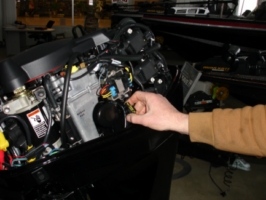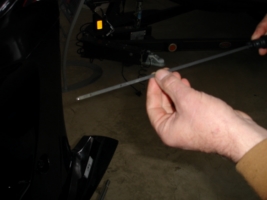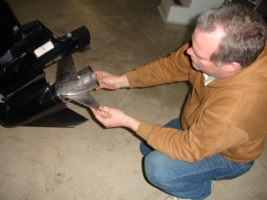Winterizing Your Four Stroke Outboard
Category: article
Nov 11th, 2010 by OutdoorsFIRST
Modified Nov 11th, 2010 at 12:00 AM
So, you’ve bought a four-stroke outboard to finally replace your old, smoky two-banger? Good for you. First of all, you’ve made a great choice. Four-stroke outboard motors may cost a little more initially but, if treated right, they are typically easier on the wallet at the gas pump and easier on the environment, as well.
But, while they may be great, they’re not maintenance-free. It takes a few simple steps to keep that four-stroke engine running trouble-free season after season, says Tim Hamelink. He is the service manager at Matteson Marine, which has been “building boating memories” on the shore of Shelbyville’s Gun Lake north of Kalamazoo, Mich., for more than 100 years.
Matteson is the home marine dealer and principal make-ready support arm for AIM Professional Angler Mark Martin. Mark relies on the marina to get his new Lund boat ready each spring for another season of demanding tournament action.
Hamelink, who has 35 years of experience wrenching on outboards, offered the following free advice to four-stroke owners. Some of this advice applies only to outboards, but other tips apply to any four-stroke engine – even your vehicle.
Number One: Change the engine oil.
“Most manufacturers specify 50 hours between oil changes if you use conventional motor oil. With synthetic oil you can easily go 100 hours,” he says. “Nonetheless, it should be changed not less than once a year regardless of the hours you total.”
Believe it or not, be sure it’s not too FULL. (And not too low, for that matter.) “All four-stroke outboards tend to ‘make’ oil during the season,” Hamelink explains. That basically means that unburned gasoline gets by the pistons to raise the oil level somewhat. The oil level will vary, depending on how many hours of use the motor accumulated last season. But don’t be surprised if it is more than full, he says.
 |
|
|
Check Oil to make sure your engine is not making oil
|
Prevent that by changing the oil before you store the engine for the winter. Fresh oil eliminates the problems associated with oil contaminated by moisture or engine deposits. “Most of the problems we see in the shop are from oil levels that are too high, which will cause spark plug fouling, especially the bottom spark plug or plugs,” Hamelink continues.
When checking that oil, especially the first time, be prepared for a different looking dipstick than your tow vehicle. “The dipsticks on four-stroke outboards aren’t like those on cars. They don’t have ‘add’ and ‘full’ marks. What they do have is a cross-hatched area. You’ll want the oil levels to start out in the middle of that crosshatch, not at the top,” he advises. “If the oil gets too high by midsummer, you’ll have spark plug problems.”
 |
|
|
Oil level should be half way on cross hatch markings
|
Number Two: Change the lower unit lube.
Now is the time to remove the old lube and replace it with fresh lubricant. “Some manufacturers require conventional oil, and some require synthetic oil. The only thing we use is synthetic. Gear cases run cooler with synthetic oil. Synthetic lower unit lube is also much more tolerant of moisture. It runs about $2 a quart more, but for the slight price difference it’s well worth it,” Hamelink says.
Number Three: Fill’er up fresh!
“This is really important. The number one problem in four-strokes we see is oil and fuel,” Hamelink says. Because four-strokes use less fuel, people tend to stretch that tank of gas into the next year, but you should scrap that thought right now.
“We used to recommend owners to fill up with gas in the fall,” Hamelink says. “Not any longer. The fuel is not good enough to last that long. The problem is that the fuel loses its octane rating over the winter. Instead, run those tanks as low as possible in fall, stabilize the fuel with a good additive like Stabil, tighten down the filler cap, and re-fill your tanks in spring,” he emphasizes. “All manufacturers say that you can run your outboard on 87 octane, but they recommend 89 because of the fuel cleaners that are in the higher octane. Most will run also on alcohol-based fuels nowadays.” However, owners of older boats still should use caution with alcohol-added gas.
Number Four: Scope out your prop.
Don’t neglect the “go” end of the motor, Hamelink says. “Be sure to check the prop in the fall for dings and damage. If it’s damaged, it may cause vibrations in the motor that will wear out parts prematurely. In addition, a damaged prop will cause other problems including reducing your top end speed and fuel efficiency. Over the winter is a good time to replace or rebuild it if it’s chunked or junked.
 |
|
|
Check your prop for damage
|
For ‘Twos’ and ‘Fours’
The remainder of Hamelink’s advice also pertains to those who are running two-stroke outboards.
Check those batteries.
Make sure your batteries are fully charged. “It’s a good idea to take them out of the boat over the winter and it pays to put a trickle charger on them,” Hamelink says. Keeping a full charge definitely extends battery life, as does keeping them somewhere they won’t freeze.
“If you are storing the batteries in the boat, unhook one of the terminals on each battery to prevent drawing any current and insuring that they remain fully charged. Normally the electronic components in modern motors will draw a little bit of current even when they are not running. As an alternative, if you have a master battery switch, you can put it in the ‘off’ position,” he says.
Grease’em up
Don’t neglect the grease fittings. Just because it’s a four-stroke doesn’t mean your new motor won’t have grease fittings needing attention. “Put a little grease on the steering arm if you have manual linkage. Turn it one way or the other to extend the arm and smear a small amount of grease on it. It should be done before winter storage,” Hamelink says. “I would then stress to hit all other accessible lube points. Anywhere there’s a fitting. But don’t over-lube. Just a couple of pumps will do it.”
Pump It Up
The last thing to check, he says, is the water pump. You have to have the motor in the water to check this – either before you take it out for the last time in the Fall or the first time you put it in the water in the Spring. “When you first start it up, make sure there’s a good water stream coming out to be sure the water pump is working properly. Also go over all fuel connectors to make sure they’re secure so a mouse hasn’t chewed through them over the winter.”
On To the Trailer
Make sure your trailer wheel bearings are in good condition. There’s nothing more sad than seeing a trailer on the side of an Interstate with its wheel/hub missing. Almost as sad as pulling your own and watching one of your trailer tires sail by your window after your own bearing has failed.
“Keep them lubricated. If you have liquid lube models be sure the level is half-way up on the clear cap,” Hamelink says. “I personally don’t like liquid lube bearings because I feel they can get contaminated easily. Have your dealer change this fluid every one or two years, according to the maintenance instructions.
“Also make sure your brake fluid is filled if the trailer is so-equipped, and all the lights are working. Newer trailers have LED lights. They’re nice and don’t burn out as often,” he adds.
Check That Owner’s Manual
Hamelink feels most owner manuals aren’t very informative for the average boater. “They’ll give you a brief overview of your motor but you don’t get lots of detail. After-market service manuals are available but it’s very difficult to do your own service past changing oil and spark plugs because motors are all computerized now.”
What about other tips? Hamelink’s best recommendation is: Fire up your kicker!
Trolling is probably the hardest activity on a big-block four-stroke. “They don’t come up to temperature, and it adds a lot of fuel into the crankcase” (see Number One above), Hamelink says. The best solution by far is a smaller kicker motor that will operate at higher internal temperatures. “The smaller kickers tend to be easier on making oil, so you won’t get that scenario that you do on bigger engines.” Why not consider adding a kicker before next Spring’s boating season?